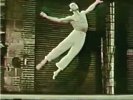Eye For Film >> Movies >> Dance In The Sun (1953) Film Review
Although she would go on to make her name as one of the most influential of experimental filmmakers, Shirley Clarke first studied as a dancer. Her style was the Martha Graham School. Clarke would go on to make other shorts, but it is in this, her Dance In The Sun, that she best expresses the spirit of dance – rather than focussing primarily on filmmaking.
The dance in question (choreographed and performed by Daniel Negrin) is a piece expressive of the forces of nature. Clarke edits the film in such a way that we repeatedly cut from a studio performance to an outdoor one. As Negrin performs a certain movement in the studio, the same movement is picked up as he dances on the sea shore. The effect is to lead the viewer into an appreciation of the vision within the dancer.

Graham was one of a small number of dancers - also including Isadora Duncan - who changed the face of modern dance forever. Dance became an expression of something from within, rather than an adornment of something else (such as music, film or theatre). In Dance In The Sun, Negrin’s movements have a fluidity, using curves more than the angular shapes of classical ballet. The dance materialises as an expression of the power of nature coming from within the human spirit. The dancer is at one with his surroundings. (The mimicking of dance movement and the movement of nature is taught more specifically in Duncan Dance. Serious readers may wish to refer to photographer Hal Eastman’s outstanding collection Natural Dance for a continuation of the ideas in this film.)
In her later shorts, Bullfight and A Moment In Love, Clarke had subsumed the supremacy of dance to her own work for the camera. Dance In The Sun, while less complex than these, uses the camera merely to help communicate aspects of the dance through another medium. Dance In The Sun would prove a building block for Clarke. In an interview with Lauren Rabinovitz, she would go on to say, "All these kind of things I discovered about the choreography of editing and the choreography of space/time came from making that very first film." Parallels to her other editing techniques abound (described in Rome Burns: A Portrait Of Shirley Clarke), such as the use of spontaneous soft focus.
While many of Shirley Clarke’s early experiments contain flaws as well as triumphs, Dance In The Sun has a single-pointedness of intention, perfectly executed.
Its major shortcoming, as with much of Clarke’s work, is that it is aimed at an educated audience already in tune with this artist’s aspirations. Without sufficient clues, like many refinements in the art world, it could leave the newcomer feeling blank.
Reviewed on: 25 Jun 2008
















